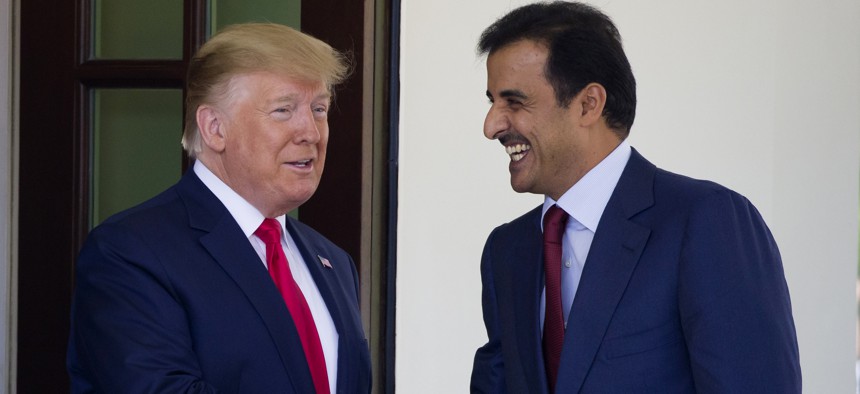
President Donald Trump shakes hands as he welcomes Qatar's Emir Sheikh Tamim bin Hamad Al Thani upon his arrival at the White House, Tuesday, July 9, 2019, in Washington. AP Photo/Alex Brandon
Fearing Iran, Qatar Continues Building its Missile Defenses
The Middle Eastern nation told the White House it would buy NASAMS and add to its Patriot batteries.
Qatar is continuing to build defenses against Iranian missiles, committing Tuesday to buy two American-made interceptors.
Qatar made a “commitment to acquire” Patriot interceptors and National Advanced Surface-to-Air Missile Systems, or NASAMS, the White House said in a statement following a meeting between President Trump and Qatari Emir Sheikh Tamim Bin Hamad Al-Thani. Both are built by Raytheon. The White House released few details about the potential sales.
“They're buying tremendous amounts of military equipment, including planes,” Trump said before his meeting with Al-Thani.
In November, the State Department approved a $215 million sale of NASAMS. Pronounced NAY-sams and installed around Washington, D.C., the system can shoot down planes, drones and cruise missiles. Raytheon has been working to extend the range of the missiles. “We’re expanding that system because of the evolving threat,” company CEO Tom Kennedy said in a July 2018 interview.
Qatar already operates Patriot. The State Department most recently approved a sale of interceptors to Doha in 2012.
Raytheon is also building a massive missile warning radar in Qatar that’s expected to be completed in 2021. The U.S. government has awarded Raytheon more than $1 billion in contracts for the radar since 2017, according to contracting documents.
Experts say Middle Eastern countries have about four minutes to act if Iran fires a missile. There’s really no one-size-fits-all system for missile defense. Different interceptors are designed to shoot down different weapons, moving at different speeds at different altitudes.
So many countries are opting for a “mixed-load approach” to missile defense, Thomas Karako, a missile defense expert with the Center for Strategic and International Studies think tank in Washington, said Tuesday. Qatar’s combining Patriot and NASAMS is similar to Poland’s pairing Patriot with SkyCepter, a lower-tier interceptor.
“One of the things we’re seeing from our customer side is really a demand for layered, integrated air and missile defense,” Ralph Acaba, president of Raytheon Integrated Defense Systems, said in an interview last month at the Paris Air Show. “I think that’s just in response to the evolving threat — coming to the realization that … no single system can really stand alone.”




